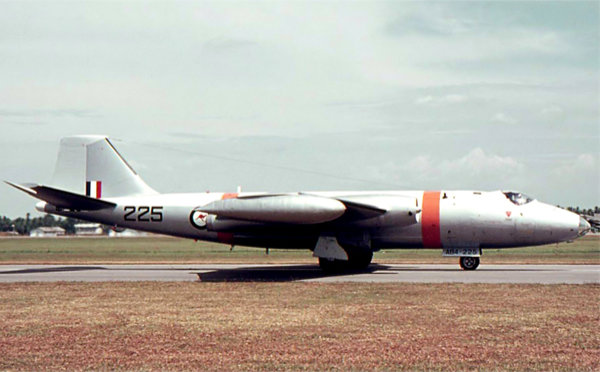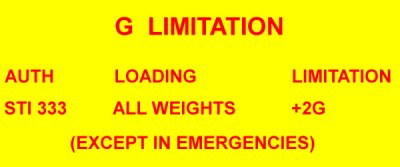Why
the Orange Bands?

Canberra
A84-225 in target-towing configuration at Butterworth in 1970.
The aircraft retained these colours when it was withdrawn
from service in January 1971.  (Picture:
John Bennett) (Picture:
John Bennett) |

Canberra
A84-224 in target-towing configuration at Butterworth.
Note that A84-224 carried the orange bands over camouflage
whereas A84-225 retained the white and silver scheme.  (Picture:
George Newbury) (Picture:
George Newbury) |
Canberra
A84-225 was modified in January 1970 for target-towing duties
with No. 1 (B) Operational Conversion Unit. Also Canberra A84-224
was similarly modified.
The target towing equipment was rather rudimentary and did not
involve anything as sophisticated as a winch. A steel stanchion
was fixed to the belly of the aircraft on the centreline aft of
the bomb bay. A 1500 foot steel cable was attached to the stanchion
with a shear link and an explosive bolt. The other end of the
cable was attached to an aluminium spreader bar which was fitted
with small wheels. The target banner was then attached to the
spreader bar. The cable and banner were laid out at the beginning
of the runway and the aircraft taxied into position where an armourer
attached the cable to the aircraft and armed the explosive bolt.
The Canberra then made a steep take-off to reduce the time the
banner was dragged along the runway. At the conclusion of the
sortie, the aircraft would fly down the runway at 500 feet and
drop the cable and banner by activating the explosive bolt.
To make the towing aircraft more visible to the Mirage fighters,
two orange (not DayGlo) bands were painted around the fuselage
fore and aft of the wing. The choice of aircraft for conversion
was probably dictated by the fact that A84-224 and A84-225 were
still fitted with Avon Mk 1 engines and had not been upgraded
to the later Avon Mk 109. Furthermore, these two aircraft were
probably already subject to G limitations, which certainly did
apply towards the end of their service lives. A84-224 is known
to have carried a large stencil forward of the cockpit entry door
as per the following facsimile:

There
is no photographic evidence that A84-225 also carried this stencil
but the aircraft records were certainly endorsed to the effect
that the aircraft was G limited. In recent years, the significance
of the orange bands has been the subject of some discussion. It
has been suggested that the orange bands signify any one of the
following:
(a) Target Tug
(b) G Limited
(c) Avon Mk 1 engines
It would appear that the reality is that the orange bands were
originally to make the aircraft more visible in its target towing
role and that the other factors were simply coincidental.
|
Issue
|
Date
|
Remarks
|
|
1
|
02MAR22
|
Original
issue. |
|




